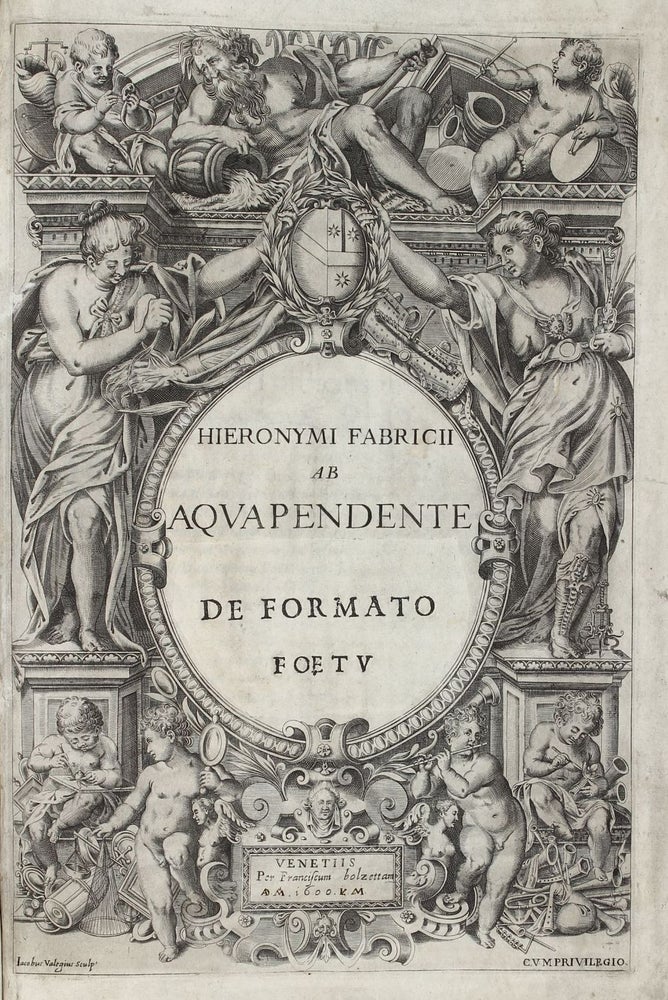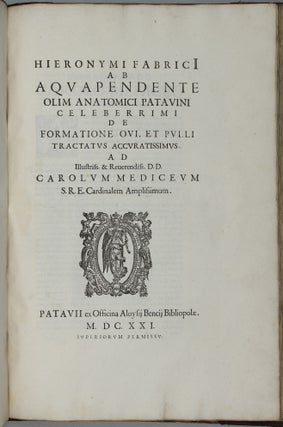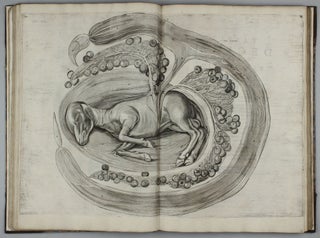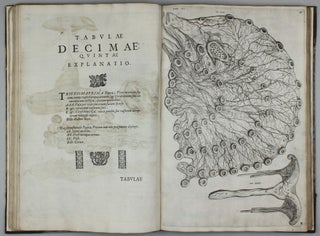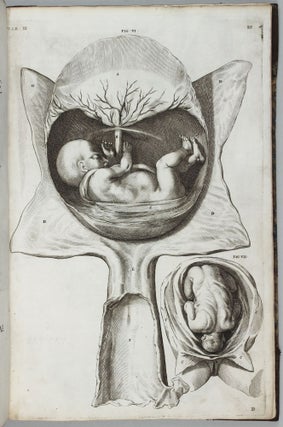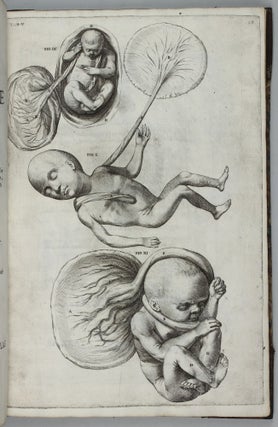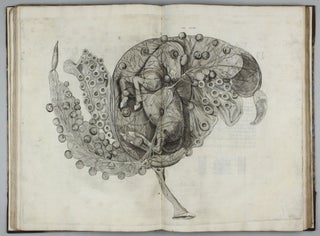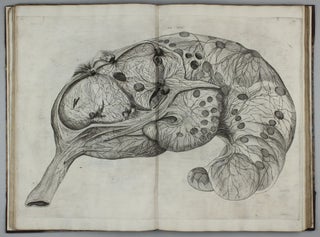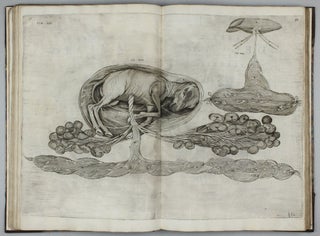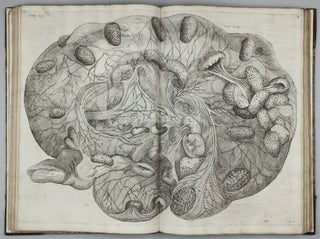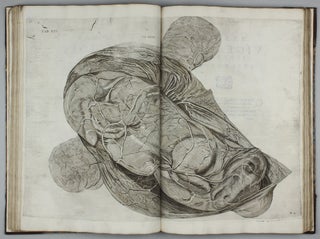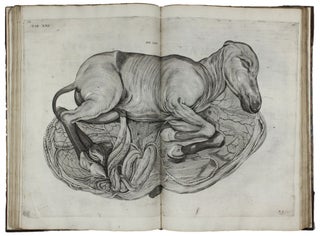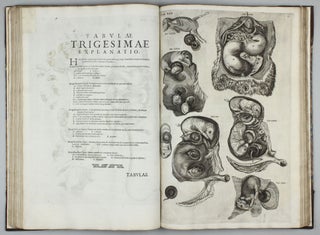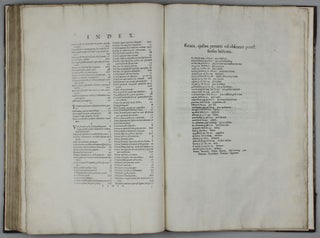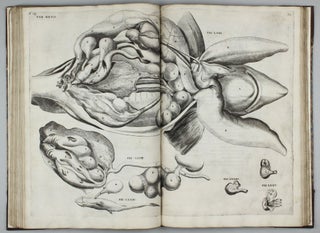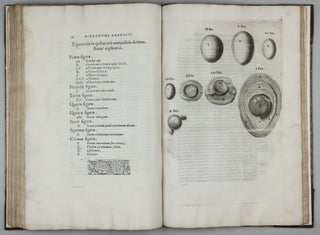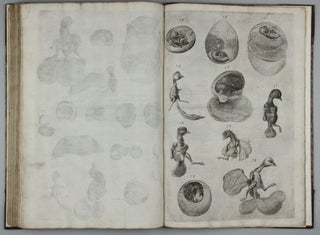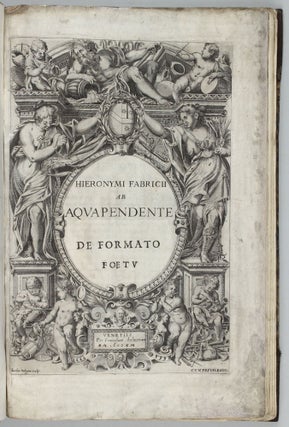Important Sammelband of Fabrici's two embryological works
De formato foetu / De formatione ovi, et pulli tractatus accuratissimu.
Padua: Lorenzo Pasquati / Aloysius Bencius, 1600.
1st Edition. Hardcover. Very Good. Item #002226
I. De formato foetu. Venice: Francesco Bolzetta, 1600 [colophon: Padua, Lorenzo Pasquati, 1604]. Folio (418 x 279 mm). [10], 1-150 [2] 151 [1] pp. Signatures: π1 a-b2, A-E4 F-I2 K4 L-O2 P4 Q2 R-Z4, Aa2, χ1. Engraved title by Giacomo Valeggio, 11 double-page, 22 full-page, and 1 half-page copper engraved illustrations, additionally numbered I-XXXIII (illustration on p.41 unnumbered), leaf χ1 with errata bound before p.151, large woodcut device and colophon on p.151 ('Patavii, Ex typographia Laurentii Pasquati, 1604'). Engraved title dust-soiled and with minor paper repair to blank fore-margin, a few plates slightly soiled or shaved just within plate mark, leaf D1 with 'Tab III' supplied, repair in margin of D2 just touching side notes. II. De formatione ovi, et pulli tractatus accuratissimu. Padua: Aloysius Bencius, 1621. Folio (415 x 277 mm). [4], 68, [2] pp. Signatures: +2 A-H4 J2 l4. Woodcut printer's device on title-page, 7 full-page illustrations, errata on final leaf. Nineteenth century half sheep with gilt letting piece (rebacked). Provenance: Library of Hugh Selbourne. A fine, wide-margined set, collated complete. ----
I. Norman 751: DSB IV, p.509-11; H. B. Adelmann, The Embyological Treatises of Hieronymus Fabricius of Aquapendente, 1942. FIRST EDITION of the author's treatise on embryology which summarizes his investigations of the fetal development of many animals, including man, contained the first detailed description of the placenta and opened the field of comparative embryology. He also gave the first full account of the larynx as a vocal organ and was first to demonstrate that the pupil of the eye changes its size. "De formato foetu, illustrates the way in which nature provides for the necessities of the fetus during its intrauterine life. It treats specifically of the umbilical vessels, the urachus, the fetal membranes, fetal waste products, the 'carnea substantia' (placenta), and the uterus. The treatise includes comparative studies of morphological details in dogs, cats, rabbits, mice, guinea pigs, sheep, cattle, goats, roebuck, horses, pigs, birds, sharks, and man. Fabrici's description of the umbilical cord and its vessels is accurate, as is his differentiation of the action of the umbilical vessels in various animals; he also provides an adequate description of the right and left atria of the heart, the foramen ovale and the ductus arteriosus, the vena cava, and the pulmonary vein in the fetus" (DSB IV, p.510).
II. Norman 752; Garrison-M. 466; DSB IV, p.509-10; NLM/Krivatsy 3826; Osler 2559; Nissen, Zool. 1328; Wood 1621; H. B. Adelmann, The Embyological Treatises of Hieronymus Fabricius of Aquapendente, 1942. FIRST EDITION. Although published after Fabrici's death, De formatione ovi et pulli is his earliest surviving treatise on embryology. The work is divided into two parts, of which the first deals with the formation of the egg and the second with the generation of the chick within the egg. The plates include the first printed illustrations of the development of the chick." (Norman). De formatione ovi et pulli is divided into two parts. The first, in three chapters, deals with the formation of the egg. The first chapter discusses the three bases of animal generation given by Aristotle (the egg, the seed, and spontaneously from decomposing materials). In the second chapter of De formatione ovi et pulli Fabrici states two functions of the 'uterus': the formation of the egg and, immediately thereafter, its nutrition. The chapter closes with a discussion of the formation of the shell; the third chapter concerns the usefulness of the uterus. The second part of the treatise, also in three chapters, is concerned with the generation of the chick within the egg and begins with a description of the eggs of various species. Many of the notions and arguments set forth in the first part of the book are then summarized. The second chapter of the second part deals with the three basic functions of the egg: the formation, growth, and nutrition of the chick. The last chapter of the treatise returns to teleology to consider the utility of both the egg and the semen of the rooster. De formatione ovi et pulli is illustrated with seven plates, of which only the first three are labeled. The last five plates are the most significant since they represent the first printed figures of the development of the chick, beginning with the third or fourth day of incubation (DSB IV, p.509-10).
Price: 28,000 € * convert currency
Delivery time up to 10 days. For calculation of the latest delivery date, follow the link: Delivery times
Lieferzeit max. 10 Tage. Zur Berechnung des spätesten Liefertermins siehe hier: Lieferzeiten


